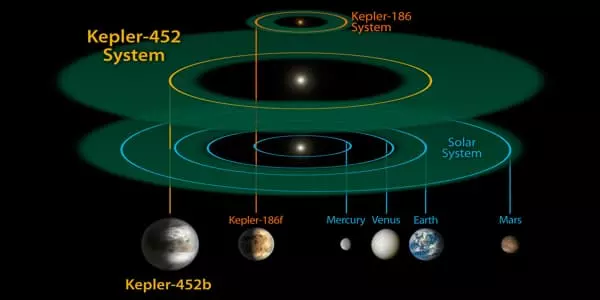Kepler-452b is the first roughly Earth-sized planet discovered in a Sun-like star’s habitable zone—the orbital region where an Earth-like planet could have liquid water on its surface and thus support life. It is the only planet discovered by Kepler in the system, and it is a super-Earth exoplanet orbiting within the inner edge of the habitable zone of the Sun-like star Kepler-452. It’s about 1,402 light-years (430 pc) away from Earth in the constellation Cygnus.
NASA’s Kepler spacecraft has discovered the first near-Earth planet in the “habitable zone” of a sun-like star. This discovery, along with the introduction of 11 new small habitable zone candidate planets, marks another step forward in the search for another “Earth.”
The newly discovered Kepler-452b is the smallest planet discovered to date orbiting a G2-type star, like our sun, in the habitable zone (the area around a star where liquid water could pool on the surface of an orbiting planet). Kepler-452b’s confirmation brings the total number of confirmed planets to 1,030.
Kepler-452b orbits its host star at a distance of 1.04 AU (156,000,000 km; 97,000,000 mi) from its host star (nearly the same distance as Earth from the Sun), with an orbital period of approximately 384 days, a mass at least 5 times that of Earth, and a radius of approximately 1.5 times that of Earth. It is the first discovered potentially rocky super-Earth planet orbiting within the habitable zone of a star similar to the Sun. However, it is unknown whether it is completely habitable because it receives slightly more energy than Earth and may be subject to a runaway greenhouse effect.
The Kepler space telescope detected the exoplanet, and NASA announced its discovery on July 23, 2015. The planet is approximately 1,400 light-years from the Solar System. It would take approximately 30 million years to get there at the speed of the New Horizons spacecraft, which travels at approximately 59,000 km/h (37,000 mph). It is approximately 1,402 light-years away from Earth.

Physical characteristics
Mass, radius, and temperature
Kepler-452b has a probable mass five times that of Earth and a surface gravity nearly twice that of Earth, though mass calculations for exoplanets are only rough estimates. Because of its higher mass and density, it is most likely a super-Earth with many active volcanoes if it is a terrestrial planet. As seen from space, the clouds on the planet would be thick and misty, covering much of the surface.
It takes 385 Earth days for the planet to orbit its star. It has a radius that is half that of Earth and is located within the parent star’s conservative habitable zone. It has an equilibrium temperature of 265 K (8 °C; 17 °F), which is slightly higher than that of Earth.
While Kepler-452b is larger than Earth, its orbit of 385 days is only 5% longer. The planet is 5% farther away from its parent star Kepler-452 than the Earth is from the Sun. Kepler-452 is 6 billion years old, 1.5 billion years older than our sun, has the same temperature, is 20% brighter, and has a 10% larger diameter.
Host star
Kepler-452 is a G-type star with roughly the same mass as the sun, only 3.7 percent more massive and 11 percent larger. It has a surface temperature of 5757 K, which is nearly identical to the Sun’s surface temperature of 5778 K. The star is estimated to be 6 billion years old, which is 1.5 billion years older than the Sun, which is 4.6 billion years old. From the surface of Kepler-452b, its star would appear nearly identical to the Sun as seen from Earth.
The apparent magnitude of the star, or how bright it appears from Earth’s perspective, is 13.426; thus, it is too dim to be seen with the naked eye.
Orbit
Kepler-452b has an orbital period of 385 days and an orbital radius of about 1.04 AU, which is nearly the same as Earth’s (1 AU). Kepler-452b’s orbit is most likely circular and not tidally locked. Kepler-452, its host star, is about 20% brighter than the Sun (L = 1.2 L☉).
















